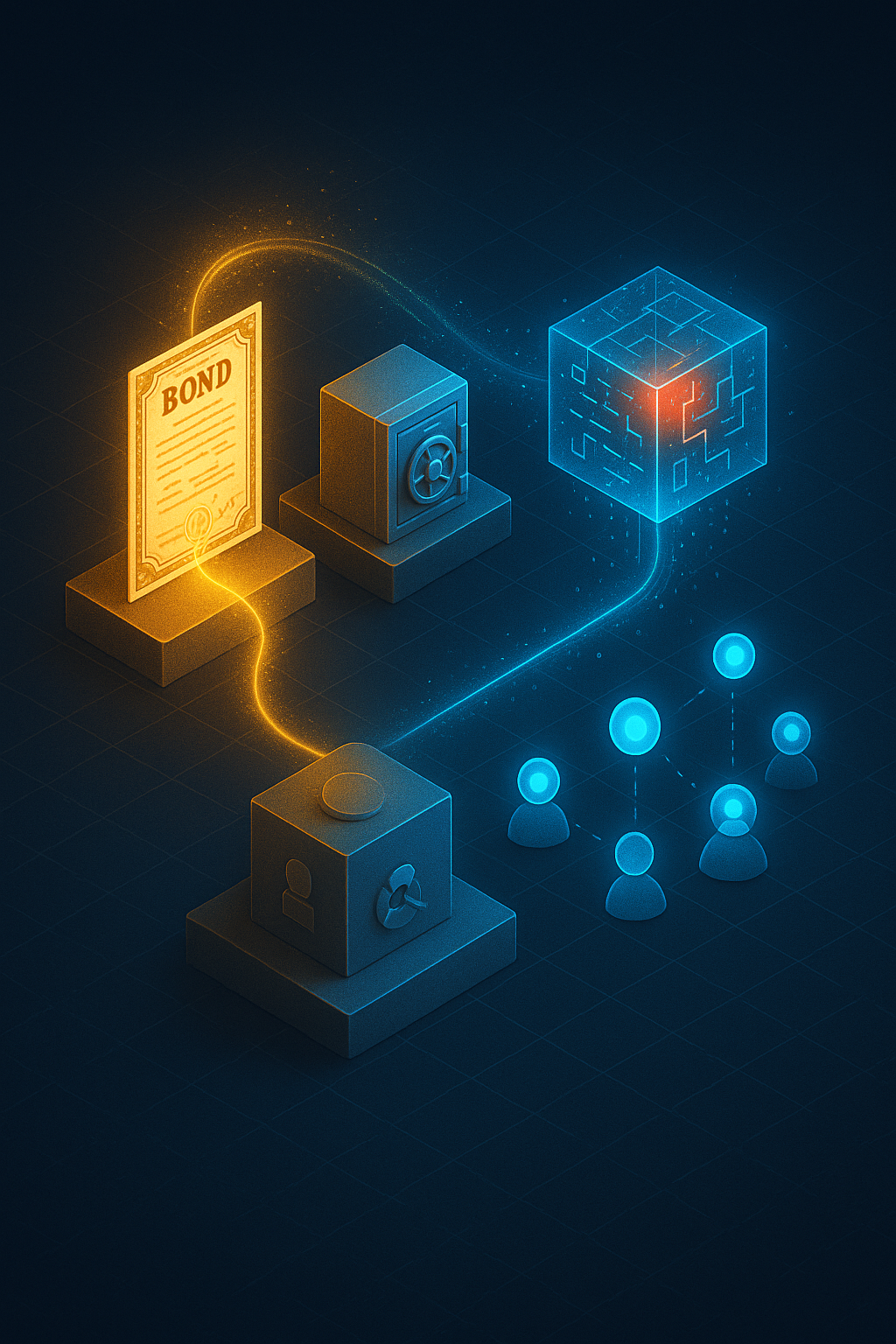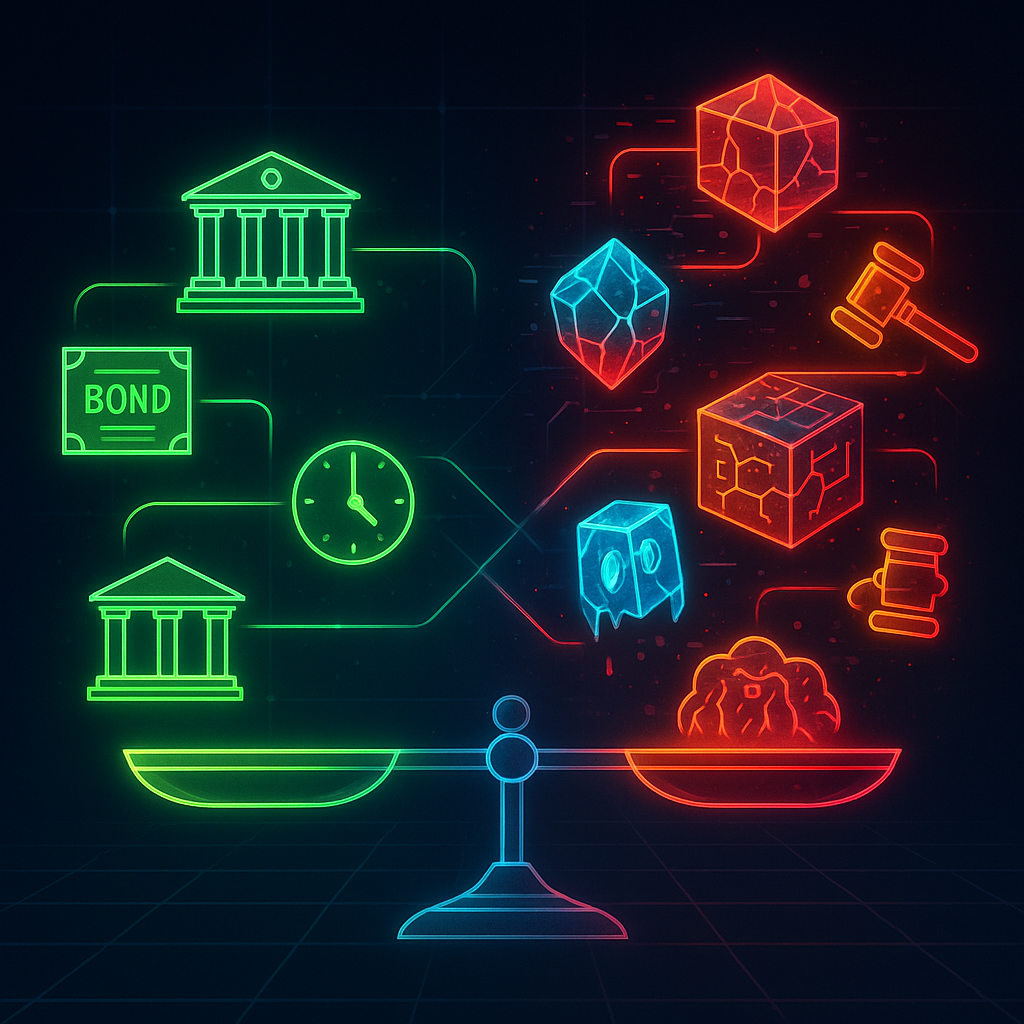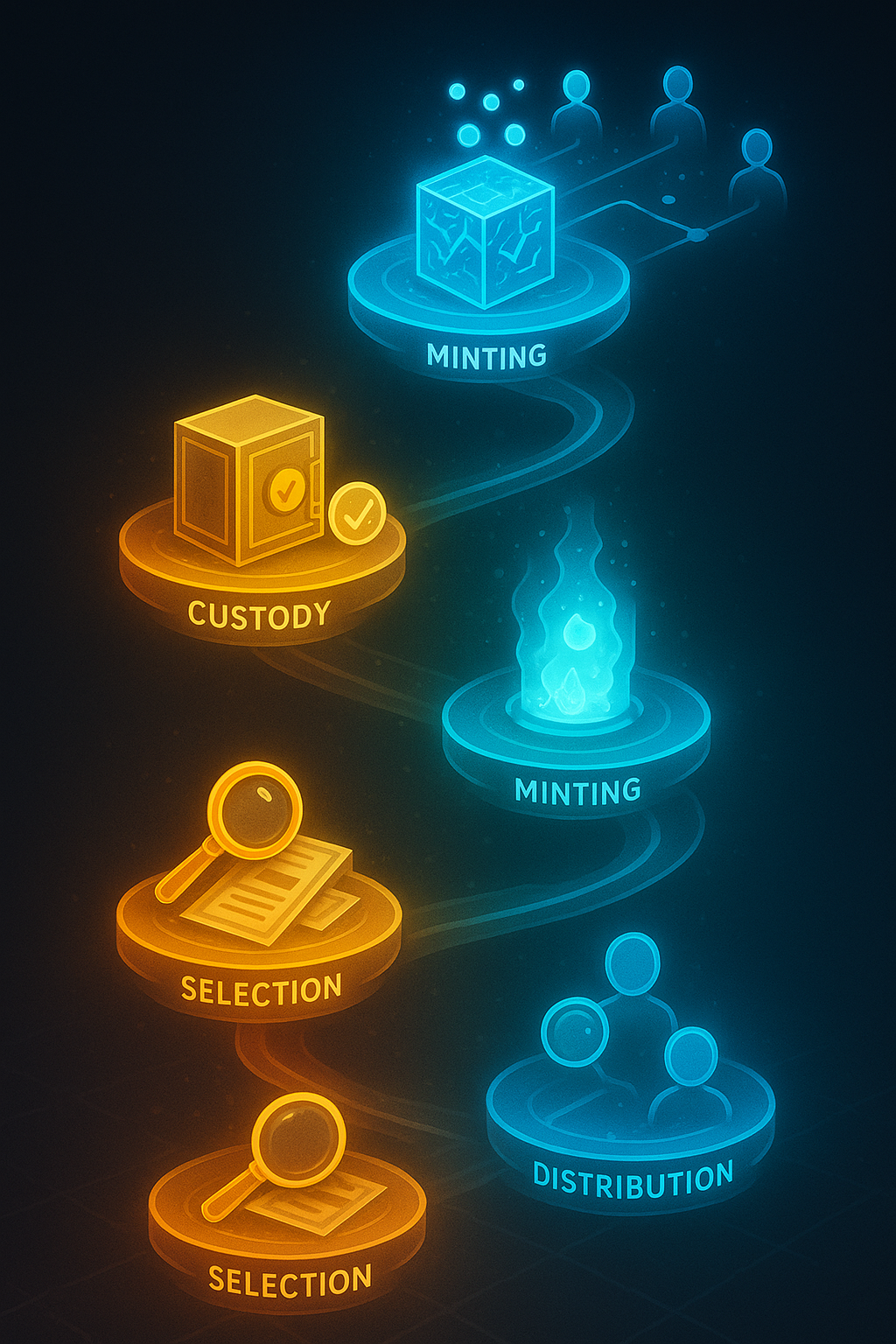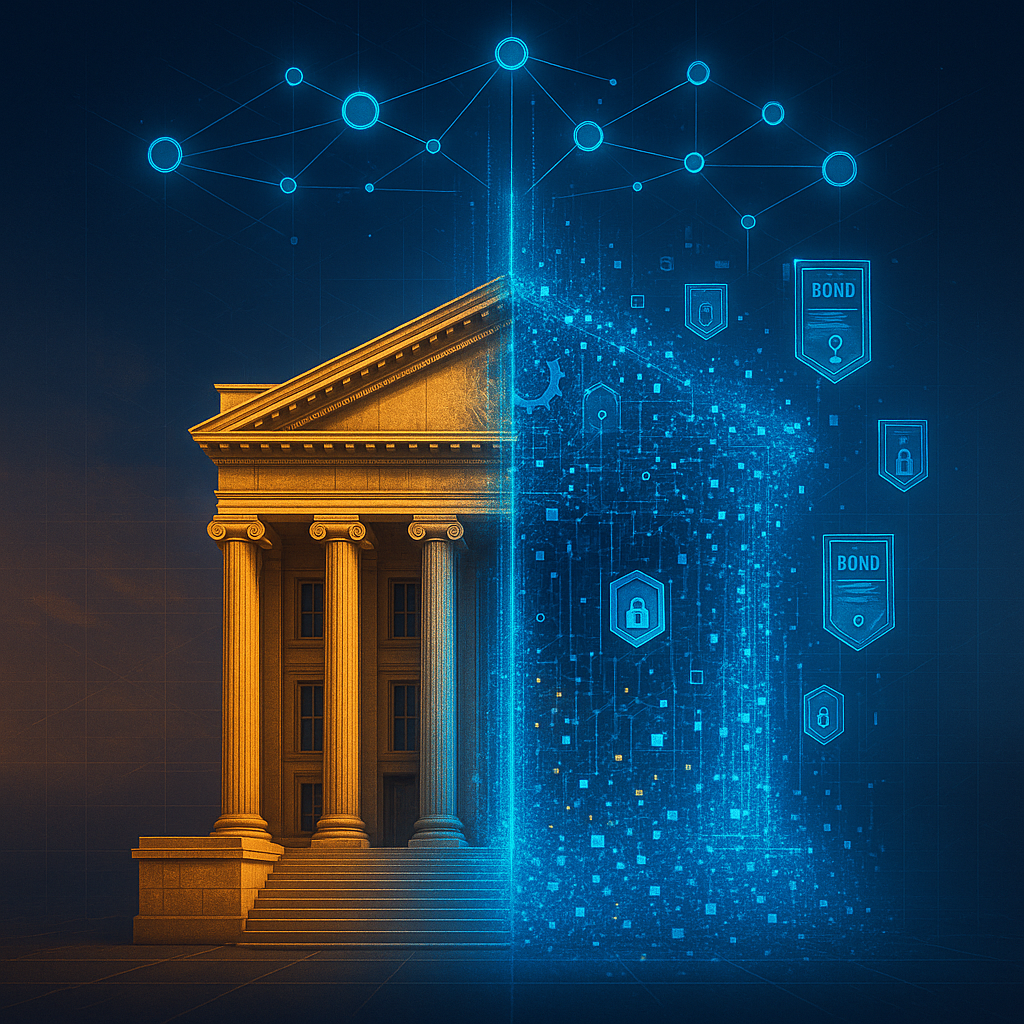Picture this: You're holding a US Treasury bond certificate from 1985. It's yellowed, stored in a safety deposit box, and worth exactly $10,000 when it matures. Now imagine that same bond living on your phone, divisible into a thousand pieces, and tradeable 24/7 with someone in Tokyo.
That's not science fiction. It's happening right now, and the market just crossed $50 billion.
Real-world asset (RWA) tokenization is turning everything from Treasury bonds to real estate into digital tokens on the blockchain. But here's what the breathless headlines aren't telling you: these aren't your typical crypto tokens. They're a fascinating hybrid of old-school finance and new-school tech, with all the benefits—and risks—that combination brings.
What You'll Understand After Reading This
You'll know exactly how a traditional Treasury bond becomes a blockchain token and what happens inside the smart contracts controlling these digital assets. You'll understand why some tokenized bonds are basically traditional bonds with extra steps, while others genuinely revolutionize how we own and trade assets. Most importantly, you'll spot the centralization risks hiding behind the "decentralized" marketing.
Because when $500 billion is projected to flow into tokenized assets by year's end, you need to know what you're really buying.
RWA Tokenization: The Bridge Between Your Bank and the Blockchain
Think of RWA tokenization like converting physical cash into Venmo balance. The money's still real, but now it's digital, programmable, and way more flexible.
When someone tokenizes a Treasury bond, they're creating a digital certificate on the blockchain that represents ownership of that actual bond sitting in a vault somewhere. The physical bond doesn't disappear—it's held by a custodian (usually a financial institution) while its digital twin lives on Ethereum or another blockchain.
Here's the game-changer: Instead of needing $100,000 to buy a Treasury bond, you can now buy $50 worth of a tokenized bond. Instead of waiting days for settlement, transactions happen in minutes. And instead of being locked into holding until maturity, you can trade your position anytime, anywhere.

Inside the Smart Contract: The Digital Vault Holding Your Assets
A tokenized Treasury bond isn't just a regular crypto token with "Treasury" slapped on it. It's controlled by a sophisticated smart contract that manages everything from ownership records to interest payments.
The Basic Architecture
Every RWA smart contract contains several key components working together:
Token Structure: The contract follows the ERC-20 standard (the same one used by most cryptocurrencies), but with extra metadata. It stores the bond's maturity date, face value, current market price, and a unique identifier linking it to the specific Treasury bond in the real world.
Access Control: This is where things get interesting—and potentially problematic. The contract defines who can do what:
- Admin Role: Can update parameters and hit the emergency pause button
- Custodian Role: The only one who can create new tokens (mint)
- Oracle Role: Updates prices based on real-world bond values
If this sounds centralized, that's because it is. We'll get to why that matters in a minute.
Core Functions: The contract includes functions to:
- Mint new tokens when real bonds are deposited
- Burn tokens when holders want to redeem for cash
- Update prices based on market conditions
- Transfer tokens between users
- Pause everything if something goes wrong
The Code That Actually Matters
Without getting too technical, here's what these functions actually do:
The mint function only works if you're the authorized custodian. When Fidelity or State Street deposits real Treasury bonds, they can create an equivalent amount of tokens. No custodian approval? No new tokens. This prevents random people from creating fake tokenized bonds.
The redeem function is your exit door. When you're ready to cash out, you tell the smart contract to burn your tokens. This triggers an off-chain process where the custodian sells the actual bonds and sends you the money. It's not instant—more like T+1 or T+2, depending on the protocol.
The price update function is constantly fed data from oracles—services that tell the blockchain what's happening in the real world. If Treasury yields jump 50 basis points, the oracle updates your token's value accordingly.
The Custodian: Your Digital Asset's Bodyguard (and Biggest Risk)
Here's where blockchain purists start getting uncomfortable. Unlike Bitcoin, which exists purely on-chain, tokenized Treasury bonds need a babysitter in the real world. That's the custodian.
These financial institutions—think State Street, BNY Mellon, or specialized crypto custodians—literally hold the physical bonds that back your tokens. They're the bridge between the blockchain and traditional finance, and wow, is that bridge important.
What Custodians Actually Do
- Hold the real assets: They keep the actual Treasury bonds in their vaults
- Verify backing: Before minting tokens, they confirm real bonds exist
- Process redemptions: When you cash out, they handle the traditional finance side
- Stay compliant: They deal with regulators, taxes, and all that fun stuff
- Report everything: They provide attestations that yes, the bonds really exist
The Custodian Catch-22
This is the dirty secret of RWA tokenization: it's only as decentralized as its most centralized component. And custodians? They're about as centralized as it gets.
If your custodian:
- Goes bankrupt (remember Silicon Valley Bank?)
- Gets hacked
- Decides to freeze assets for "compliance reasons"
- Simply makes a mistake
Your "decentralized" tokens become worthless receipts for assets you can't access.

The Oracle Problem: When Blockchains Need to Phone a Friend
Blockchains are incredibly secure partially because they're isolated from the outside world. But tokenized bonds need real-world data—current prices, interest rates, maturity dates. Enter oracles.
Oracles are like translators between the blockchain and reality. For tokenized Treasury bonds, they:
- Pull current bond prices from financial markets
- Verify the bonds still exist (proof of reserves)
- Update values when interest rates change
- Trigger automatic payments at maturity
Why This Matters More Than You Think
Remember February 2025? An attacker manipulated VaultFi's oracle by flash-loaning 40,000 ETH and creating a fake price crash. The protocol thought bonds were worth 22% less and liquidated $56 million worth of positions. The real bond market hadn't moved an inch.
Good protocols use multiple oracle sources, sanity checks, and circuit breakers. Bad ones trust a single price feed and hope for the best. Guess which type tends to offer higher yields to attract users?
From Paper to Pixels: How Bonds Actually Get Tokenized
The journey from traditional Treasury bond to blockchain token isn't just clicking "tokenize" in some app. It's a complex process involving lawyers, custodians, and a lot of paperwork—ironic for something meant to eliminate paperwork.
Step 1: Asset Selection and Legal Structure
First, someone (usually an institution) decides which Treasury bonds to tokenize. They set up legal structures—often Special Purpose Vehicles (SPVs)—to hold the assets. This isn't crypto cowboy stuff; it's traditional finance in a digital wrapper.
Step 2: Custody and Verification
The bonds are deposited with a qualified custodian who verifies their authenticity and takes legal possession. This is crucial—no verified bonds, no valid tokens.
Step 3: Smart Contract Deployment
The technical team deploys the smart contract with all the bond's details: maturity date, interest rate, face value. The contract is configured with the right addresses for admins, custodians, and oracles.
Step 4: Token Minting
Once everything's verified, the custodian triggers the mint function, creating tokens that represent fractional ownership of the underlying bonds. If they're tokenizing $10 million in bonds, they might create 10 million tokens worth $1 each.
Step 5: Distribution and Trading
The tokens are distributed to investors who can now trade them on compatible exchanges or hold them to earn yield. The smart contract automatically handles interest distributions based on token holdings.

Getting Your Money Back: The Redemption Reality Check
So you've made your profit (or cut your losses) and want out. How does a digital token turn back into real dollars?
The redemption process reveals the true nature of tokenized assets—they're only as liquid as their redemption mechanism allows. Here's what actually happens:
- You initiate redemption: Through the protocol's interface, you request to burn your tokens for cash value
- Smart contract burns tokens: Your tokens are destroyed, removing them from circulation
- Off-chain magic happens: The custodian receives notification and begins selling the actual bonds
- Settlement time: Unlike instant crypto swaps, you're back in traditional finance time—expect 1-3 business days
- Money arrives: Finally, dollars (or stablecoins) hit your account
Some protocols promise T+0 (same day) settlement. Others might take a week. During volatile markets, that timing difference can cost you thousands.
The Centralization Nobody Wants to Talk About
Let's address the elephant in the room: tokenized RWAs are centralized by design, and that's not necessarily bad—if you know what you're signing up for.
Admin Powers That Would Make a Crypto Anarchist Cry
Most RWA smart contracts give administrators powers that would be unthinkable in DeFi:
- Pause all transfers: One button freezes everyone's tokens
- Change custodians: Swap out who holds the real assets
- Update oracles: Change where price data comes from
- Upgrade contracts: Potentially rewrite the rules entirely
These aren't bugs; they're features. They exist because tokenized bonds must comply with traditional finance regulations. If the SEC comes knocking, that pause button might be the only thing keeping the protocol alive.
The Custodian Kingdom
Your tokenized Treasury bond is only as secure as:
- The custodian's security practices
- Their regulatory compliance
- Their solvency
- Their honesty
That's four single points of failure for an asset class marketing itself on blockchain's resilience.
Oracle Oligarchy
Even "decentralized" oracle networks often rely on a handful of data providers. If three out of five oracle nodes get their data from the same Bloomberg terminal, how distributed is your price feed really?
Real Examples: The Good, The Bad, and The Regulated
Several major projects are already tokenizing Treasury bonds at scale:
Franklin Templeton's FOBXX: One of the first tokenized money market funds, holding over $400 million. It's basically a traditional fund that happens to issue blockchain-based shares. Conservative, compliant, and honestly, kind of boring—which is exactly what some investors want.
Ondo Finance: Offers tokenized Treasury products with different risk profiles. Their OUSG token tracks short-term Treasury yields and has attracted over $150 million. They're transparent about centralization risks and have institutional-grade providers.
Maple Finance: Focused on institutional lending backed by real-world assets. They've processed over $2 billion in loans, though they've also experienced defaults that tested their risk management systems.
Each project makes different trade-offs between decentralization, compliance, and yield. None are purely decentralized, and the most successful ones don't pretend to be.
The $5 Trillion Question: Is This the Future?
Market projections suggest tokenized assets could hit $5 trillion by 2030. That's not just optimistic—it represents a fundamental shift in how financial assets work.
The benefits are real:
- Fractional ownership: Buy $50 of a Treasury bond instead of $10,000
- 24/7 trading: Markets never close on the blockchain
- Instant settlement: Transfer ownership in minutes, not days
- Programmable money: Automate interest payments, tax withholding, and more
- Global access: Anyone with internet can access US Treasury yields
But so are the challenges:
- Regulatory uncertainty: Rules are still being written
- Technical complexity: More moving parts mean more potential failures
- Centralization risks: Not your custodian, not your bonds
- Limited liquidity: Many tokenized assets trade at discounts to NAV
- Smart contract risks: Code bugs can lock or lose millions
What This Means for You
If you're considering tokenized Treasury bonds, here's your checklist:
- Understand the custodian: Who holds the real assets? What's their track record?
- Check the smart contract: Who has admin powers? How are they limited?
- Verify oracle sources: Single oracle = single point of failure
- Test redemption: Can you actually exit when you want?
- Compare yields: Higher yields often mean higher risks
- Read the audits: Not just that they exist, but what they found
The Smart Contract Reality Check
Here's where understanding the actual smart contract becomes crucial. A tokenized Treasury bond contract can have hidden fees, lock-up periods, or emergency powers you'd never accept if you knew about them.
This is exactly what ChainDecode helps you uncover. Instead of trusting marketing materials, you can verify exactly what powers the admin has, how redemption really works, and what happens in edge cases. Paste any RWA token contract address and see—in plain English—what you're really buying into. Because in tokenized assets, the smart contract IS the product.
The Bottom Line: Evolution, Not Revolution
Tokenized Treasury bonds aren't replacing traditional bonds—they're adding a digital layer that makes them more accessible and flexible. It's evolution, not revolution, and that's probably a good thing.
The technology works. Major institutions are adopting it. Regulators are (slowly) providing clarity. But success requires understanding that "tokenized" doesn't mean "decentralized," and "blockchain-based" doesn't eliminate traditional finance risks.
As this market grows from $50 billion to potentially $500 billion, the winners will be those who understand both what these tokens enable and what they still require: trust in institutions, regulatory compliance, and good old-fashioned due diligence.
The future of finance might be tokenized, but it's still anchored in the real world. Make sure you understand both sides of that bridge before you cross it.


